Retirees face a myriad of questions as they head into the next chapter of their lives. At the top of the list is whether they have enough resources to last a lifetime. A related question is how much they can reasonably spend throughout retirement.
But retirement is more than just having a large enough pile of money to live a comfortable lifestyle. Here are some of the biggest questions facing retirees today:
Should I pay off my mortgage?
The continuous climb up the property ladder means more Canadians are carrying mortgages well into retirement. What was once a cardinal sin of retirement is now becoming more common in today’s low interest rate environment.
It’s still a good practice to align your mortgage pay-off date with your retirement date (ideally a few years earlier so you can use the freed-up cash flow to give your retirement savings a final boost). But there’s nothing wrong with carrying a small mortgage into retirement provided you have enough savings, and perhaps some pension income, to meet your other spending needs.
Which accounts to tap first for retirement income?
Old school retirement planning assumed that we’d defer withdrawals from our RRSPs until age 71 or 72 while spending from non-registered funds and government benefits (CPP and OAS).
That strategy is becoming less popular thanks to the Tax Free Savings Account. TFSAs are an incredible tool for retirees that allow them to build a tax-free bucket of wealth that can be used for estate planning, large one-time purchases or gifts, or to supplement retirement income without impacting taxes or means-tested government benefits.
Now we’re seeing more retirement income plans that start spending first from non-registered funds and small RRSP withdrawals while deferring CPP to age 70. Depending on the income needs, the retiree could keep contributing to their TFSA or just leave it intact until OAS and CPP benefits kick-in.
This strategy spends down the RRSP earlier, which can potentially save taxes and minimize OAS clawbacks later in retirement, while also reducing the taxes on estate. It also locks-in an enhanced benefit from deferring CPP: benefits that are indexed to inflation and paid for life. Finally, it can potentially build up a significant TFSA balance to be spent in later years or left in the estate.
Should I switch to an income-oriented investment strategy?
The idea of living off the dividends or distributions from your investments has long been romanticized. The challenge is that most of us will need to dip into our principal to meet our ongoing spending needs.
Consider Vanguard’s Retirement Income ETF (VRIF). It targets a 4% annual distribution, paid monthly, and a 5% total return. That seems like a logical place to park your retirement savings so you never run out of money.
VRIF can be an excellent investment choice inside a non-registered (taxable) account when the retiree is spending the monthly distributions. But put VRIF inside an RRSP or RRIF and you’ll quickly see the dilemma.
RRIFs come with minimum mandatory withdrawal rates that increase over time. You’re withdrawing 5% of the balance at age 70, 5.28% at age 71, 5.40% at age 72, and so on.
That means a retiree will need to sell off some VRIF units to meet the minimum withdrawal requirements.
Replace VRIF with any income-oriented investment strategy in your RRSP/RRIF and you have the same problem. You’ll eventually need to sell shares.
This also doesn’t touch on the idea that a portfolio concentrated in dividend stocks is less diversified and less reliable than a broadly diversified (and risk appropriate) portfolio of passive investments.
By taking a total return approach with your investments you can simply sell off ETF units as needed to generate your desired retirement income.
When to take CPP and OAS?
I’ve written at length about the risks of taking CPP at 60 and the benefits of taking CPP at 70. But it doesn’t mean you’re a fool to take CPP early. CPP is just one piece of the retirement income puzzle. Continue Reading…








